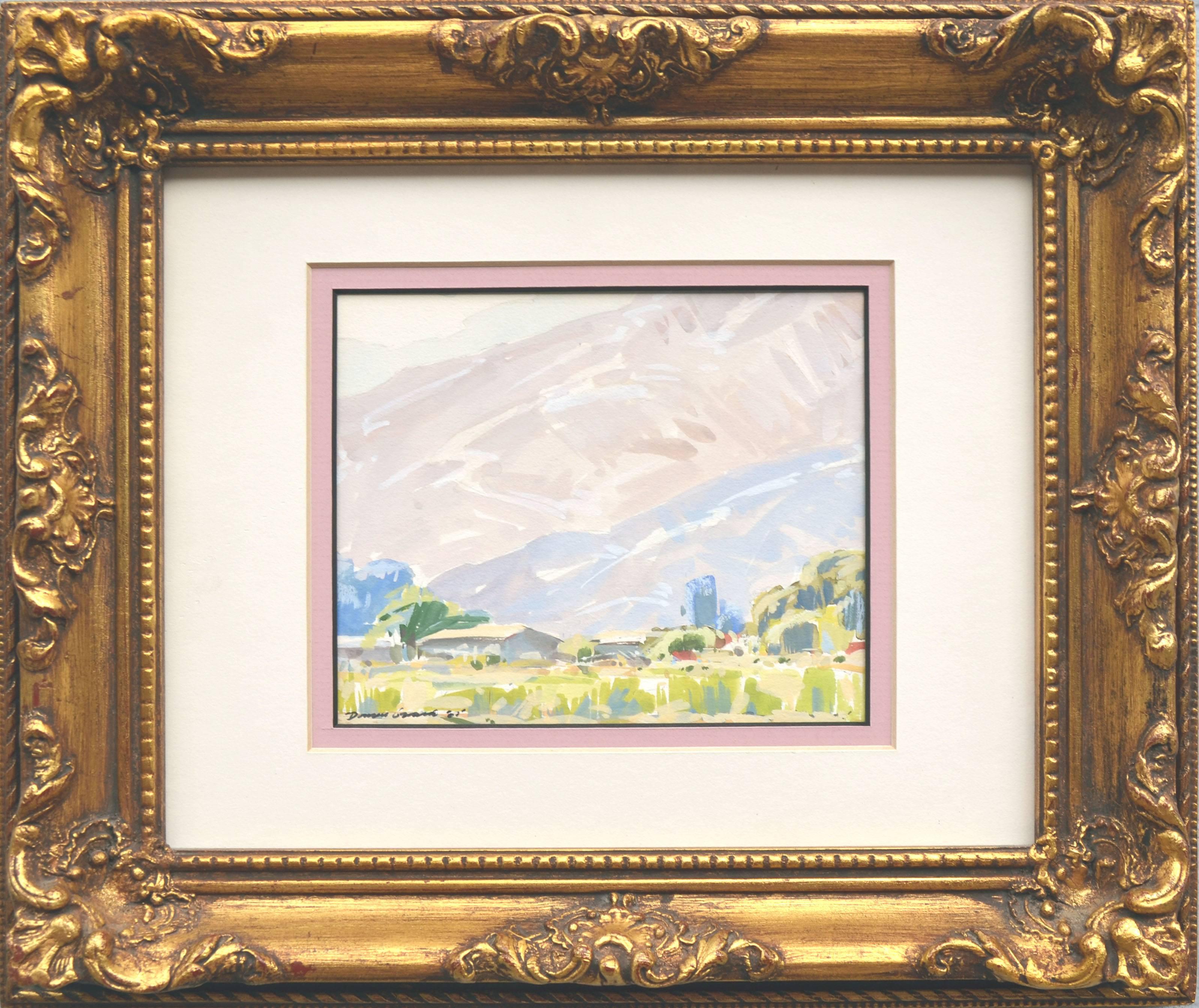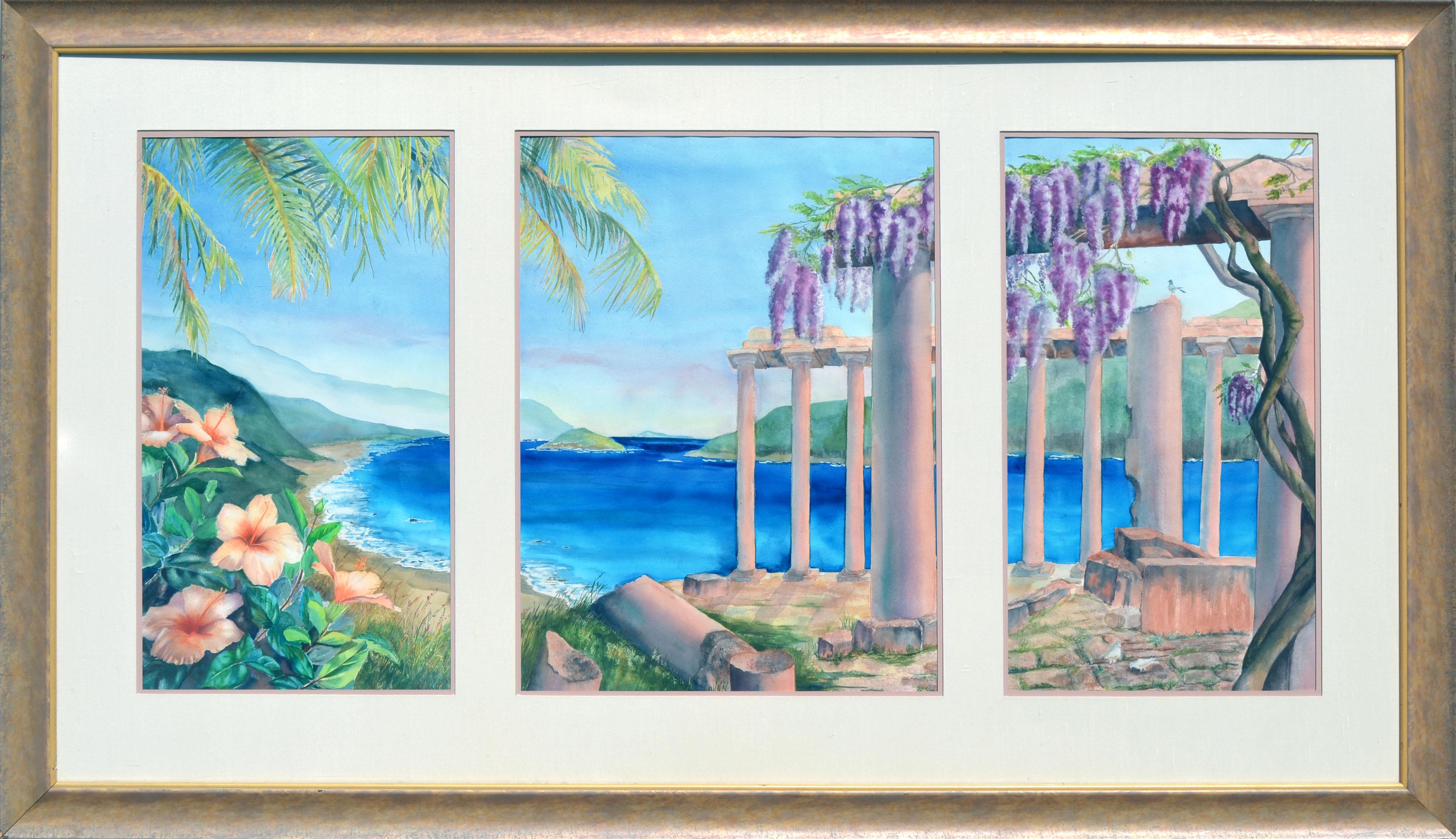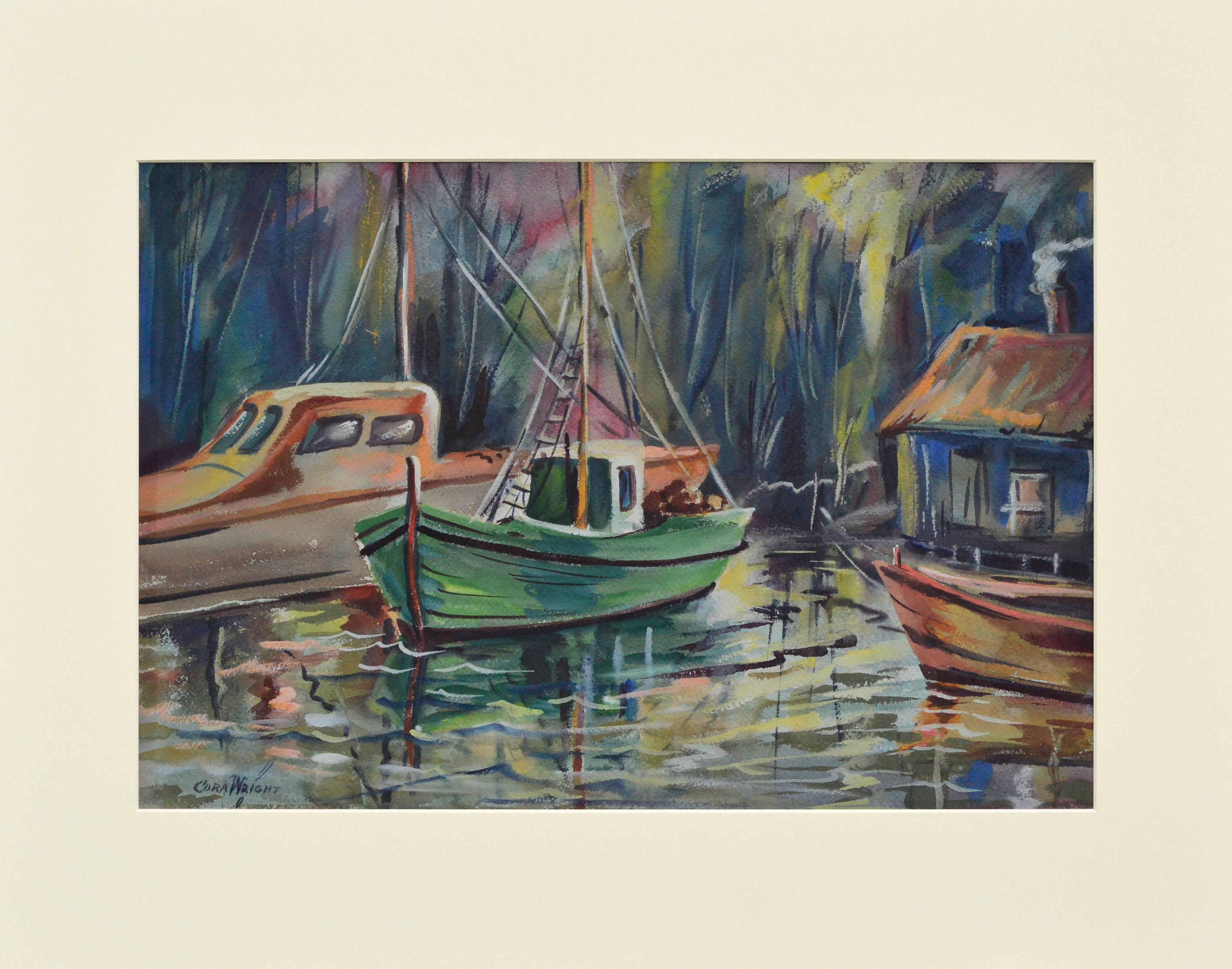Margaret E. Rogers1930's California Watercolor Landscape -- "Palm Trees" 1930
1930
About the Item
- Creator:Margaret E. Rogers (1872 - 1961, American)
- Creation Year:1930
- Dimensions:Height: 20 in (50.8 cm)Width: 18 in (45.72 cm)Depth: 1 in (2.54 cm)
- Medium:
- Movement & Style:
- Period:
- Condition:Some slight age toning to paper.
- Gallery Location:Soquel, CA
- Reference Number:
Margaret E. Rogers
Margaret E. Rogers was one of the original "Jolly Daubers" with Cornelia DeGavere, Leonora Penniman and Louise Cunningham, Santa Cruz Art League Founding Members. She studied with Frank Heath on many wagon trips to Big Basin and Yosemite. Born in Birmingham, England, on May 1, 1872, the Rogers family immigrated to California in 1875 and established a prosperous sheep ranch in Monterey County. In her youth, Rogers was known as one of the finest horsewomen in the West. The magazine Western Woman said of her, “She could break the worst kind of bucking bronco without assistance; with the utmost ease she drove six or eight horses hitched together in a manner that would win admiration from the most experienced stage drivers of the old days." Rogers left her father's ranch in 1905 and moved to nearby Santa Cruz, where she settled in the Seabright area. For many years, she lived in the back of the old Tyrell house (now the site of the Natural History Museum on East Cliff Drive). It housed the Santa Cruz Art League, of which she was a cofounder in 1919. Rogers’ art studies were under local artists Frank L. Heath and Lorenzo P. Latimer. She and her constant painting companions, Cornelia DeGavere and Leonora Penniman, were known as the "Santa Cruz Three" and made many camping trips into the Sierra and surrounding area. A spinster, Rogers died in Santa Cruz, California, on March 15, 1961.
- ShippingRetrieving quote...Ships From: Soquel, CA
- Return PolicyA return for this item may be initiated within 14 days of delivery.
- Blue Hills LandscapeLocated in Soquel, CAGorgeous watercolor painting of a landscape depicting light blue hills with faint pink mountains in the background and vibrant green grasslands in the front....Category
1980s American Impressionist Landscape Paintings
MaterialsLaid Paper, Watercolor
- Minimalist Mid Century Modern Landscape -- Autumn TreesLocated in Soquel, CAMinimalist mid-century modern landscape of three autumnal trees by M. Lehtio (American, 20th century). Signed "M. Lehtio" and dated "48." Presented in a wood frame and non-glare glas...Category
1940s American Impressionist Landscape Paintings
MaterialsWatercolor, Laid Paper
- Mid Century Tonalist Landscape of California Country RoadLocated in Soquel, CABeautiful tonalist landscape of California foothills and country road. Signed and dated "CKP" and "'69" lower right corner. Presented in rustic wood frame with eggshell mat under nonglare glass. Image size: 18.25"H x 13.25"W. Framed size: 23.5"H x 18"W. California Tonalism was art movement that existed in California from circa 1890 to 1920. Tonalist are usually intimate works, painted with a limited palette. Tonalist paintings are softly expressive, suggestive rather than detailed, often depicting the landscape at twilight or evening, when there is an absence of contrast. Tonalist paintings could also be figurative, but in them, the figure was usually out of doors or in an interior in a low-key setting with little detail. Tonalism had its origins in the works of the French Barbizon school and in the works of American painters who were influenced by them. California Tonalism was born when the emphasis in California landscape painting passed from the grand landscapes of works like those of Thomas Hill and William Keith's early career, to more intimate views of a domesticated landscape. At the same time, the parallel Pictorialist Photography...Category
1960s American Impressionist Landscape Paintings
MaterialsGouache, Laid Paper
- Large Scale Triptych Watercolor Landscape -- Paradise CoveLocated in Soquel, CAA secluded ancient site with lush foliage overlooking a brilliant blue cove is the subject of this watercolor triptych combined in single framing by artist Isabel McCauley...Category
1990s American Impressionist Landscape Paintings
MaterialsWatercolor, Laid Paper
- Mid Century Fishing Boats LandscapeLocated in Soquel, CAVibrant watercolor of three fishing boats by Cora Alice Akers Wright (American, 1908-1992). which are anchored in a small body of water. Signed...Category
Early 20th Century American Impressionist Landscape Paintings
MaterialsWatercolor, Laid Paper
- California Wetland Ponds Landscapes (Two Sided)Located in Soquel, CAWonderful two sided landscape of California wetlands with pond. Circa 1960s. Monogramed. Image size: 19"H x 25"W. Presented in wood frame. Frame size: 19"H x 25"W. One side Meadow ...Category
1990s American Impressionist Landscape Paintings
MaterialsWatercolor, Laid Paper
- "Beach House Scene" American Impressionism Coastal Landscape Watercolor on PaperBy Martha WalterLocated in New York, NYThis piece is a playful depiction of a beach house scene of the ocean, sand, and view of a house with its garden with joyful colors and precious deta...Category
Early 20th Century American Impressionist Landscape Paintings
MaterialsPaper, Watercolor
- Study for Skunk Cabbage, Watercolor Painting by Charles Burchfield 1931By Charles E. BurchfieldLocated in Long Island City, NYA watercolor painting by Charles Burchfield from 1931. A still life botanical painting of a skunk cabbage in natural setting. Signed and dated in lower right, beautifully matted and framed in gold ornate frame. The painting has an excellent provenance through top New York Galleries including DC Moore...Category
1930s American Impressionist Landscape Paintings
MaterialsWatercolor, Paper
- "Park Street Church, Boston, " John Whorf Impressionist Watercolor WPA CityscapeBy John WhorfLocated in New York, NYJohn Whorf (1903 - 1959) Park Street Church, Boston, circa 1930-45 Watercolor on paper 21 x 15 inches Signed lower right Housed in its original frame Provenance: Milch Gallery, New ...Category
1930s American Impressionist Landscape Drawings and Watercolors
MaterialsWatercolor, Paper
- Mount MonadnockBy Gifford BealLocated in Milford, NHA fine monochromatic watercolor landscape painting of Mount Monadnock in New Hampshire by American artist Gifford Beal (1879-1956). Beal was born in New York City and studied for man...Category
Mid-20th Century American Impressionist Landscape Drawings and Watercolors
MaterialsPaper, Watercolor
- "Old Adobe Village, New Mexico" Alice Schille, Taos Pueblo, Female ImpressionistBy Alice SchilleLocated in New York, NYAlice Schille Old Adobe Village, New Mexico Signed lower right Watercolor on paper 5 x 6 inches Provenance: Estate of the artist Keny and Johnson Gallery, Columbus, Ohio Santa Fe East Galleries, Santa Fe, New Mexico Private Collection, California A painter in watercolor and oil, Alice Schille was a prolific artist using modernist styles of Post-Impressionism, Pointillism and Fauvism. Her subjects included portraits of women and children, landscapes with and without figures, a series of scenes of New York City. New Mexico, and Gloucester, Massachusetts. Her paintings also reflected her widespread international travels in Europe, North Africa, Russia, the Middle East, Mexico, and Guatemala. Although personally very shy, Schille possessed unusual courage and strength of will, which was reflected in both her independent lifestyle and in her work, as she continually worked to master new modes of painting throughout her career. A German critic once referred to Schille as "this daredevil disciple of art who is interested in anything and afraid of nothing." Alice Schille was born in Columbus, Ohio to a family supported by her father's success in manufacturing. She was raised in Columbus, and by the time she was age six, she determined to be an artist. She graduated at the top of her class from Central High School in 1887, studied from 1891 to 1893 at the Columbus Art School, and returned there as a teacher from 1902 to 1948. Going to New York City as a young woman, she enrolled in the Art Students League from 1897 to 1899 and then the New York School of Art with William Merritt Chase and Kenyon Cox. (Some years later, she attended Chase's Shinnecock Summer School on Long Island). From 1903 to 1904, Alice Schille was in Paris at the Academie Colarosi, and also studied privately with Raphael Collin, Rene Prinet, Gustave Courtois and Chase, who was then in Europe. In 1904, five of her paintings were accepted for exhibition at Societe Nationale des Beaux Arts, and from that time on her work was included regularly in important American annual exhibitions including the Pennsylvania Academy, the Corcoran Gallery, American Watercolor Society, Boston Art Club, and the 1987 inaugural exhibition of the National Museum of Women in the Arts in Washington DC. Between 1905 and 1914, Alice Schille painted in Europe, and during the summers of 1916 to 1918, worked in New York and Gloucester. In 1919, she was in New Mexico. On this trip, her first to the Southwest, she spent a summer in Taos and Santa Fe and painted scenes including the Taos Pueblo, Canyon Road and local Hispanic and Indian figures. Reportedly the Ranchos de Taos Church was one of her favorite subjects. Many of these New Mexico paintings were hung at annual exhibitions of the Philadelphia Water Color Club. Between 1920 and 1940, she traveled frequently in the summers, returning to New Mexico and going to Central America and Africa. In 1922, she began her first series of North-African watercolors...Category
1920s American Impressionist Landscape Drawings and Watercolors
MaterialsPaper, Watercolor
- "Train Station, " Max Kuehne, Industrial City Scene, American ImpressionismBy Max KuehneLocated in New York, NYMax Kuehne (1880 - 1968) Train Station, circa 1910 Watercolor on paper 8 1/4 x 10 1/4 inches Signed lower right Provenance: Private Collection, Illinois Max Kuehne was born in Halle, Germany on November 7, 1880. During his adolescence the family immigrated to America and settled in Flushing, New York. As a young man, Max was active in rowing events, bicycle racing, swimming and sailing. After experimenting with various occupations, Kuehne decided to study art, which led him to William Merritt Chase's famous school in New York; he was trained by Chase himself, then by Kenneth Hayes Miller. Chase was at the peak of his career, and his portraits were especially in demand. Kuehne would have profited from Chase's invaluable lessons in technique, as well as his inspirational personality. Miller, only four years older than Kuehne, was another of the many artists to benefit from Chase's teachings. Even though Miller still would have been under the spell of Chase upon Kuehne's arrival, he was already experimenting with an aestheticism that went beyond Chase's realism and virtuosity of the brush. Later Miller developed a style dependent upon volumetric figures that recall Italian Renaissance prototypes. Kuehne moved from Miller to Robert Henri in 1909. Rockwell Kent, who also studied under Chase, Miller, and Henri, expressed what he felt were their respective contributions: "As Chase had taught us to use our eyes, and Henri to enlist our hearts, Miller called on us to use our heads." (Rockwell Kent, It's Me O Lord: The Autobiography of Rockwell Kent. New York: Dodd, Mead and Co., 1955, p. 83). Henri prompted Kuehne to search out the unvarnished realities of urban living; a notable portion of Henri's stylistic formula was incorporated into his work. Having received such a thorough foundation in art, Kuehne spent a year in Europe's major art museums to study techniques of the old masters. His son Richard named Ernest Lawson as one of Max Kuehne's European traveling companions. In 1911 Kuehne moved to New York where he maintained a studio and painted everyday scenes around him, using the rather Manet-like, dark palette of Henri. A trip to Gloucester during the following summer engendered a brighter palette. In the words of Gallatin (1924, p. 60), during that summer Kuehne "executed some of his most successful pictures, paintings full of sunlight . . . revealing the fact that he was becoming a colorist of considerable distinction." Kuehne was away in England the year of the Armory Show (1913), where he worked on powerful, painterly seascapes on the rocky shores of Cornwall. Possibly inspired by Henri - who had discovered Madrid in 1900 then took classes there in 1906, 1908 and 1912 - Kuehne visited Spain in 1914; in all, he would spend three years there, maintaining a studio in Granada. He developed his own impressionism and a greater simplicity while in Spain, under the influence of the brilliant Mediterranean light. George Bellows convinced Kuehne to spend the summer of 1919 in Rockport, Maine (near Camden). The influence of Bellows was more than casual; he would have intensified Kuehne's commitment to paint life "in the raw" around him. After another brief trip to Spain in 1920, Kuehne went to the other Rockport (Cape Ann, Massachusetts) where he was accepted as a member of the vigorous art colony, spearheaded by Aldro T. Hibbard. Rockport's picturesque ambiance fulfilled the needs of an artist-sailor: as a writer in the Gloucester Daily Times explained, "Max Kuehne came to Rockport to paint, but he stayed to sail." The 1920s was a boom decade for Cape Ann, as it was for the rest of the nation. Kuehne's studio in Rockport was formerly occupied by Jonas Lie. Kuehne spent the summer of 1923 in Paris, where in July, André Breton started a brawl as the curtain went up on a play by his rival Tristan Tzara; the event signified the demise of the Dada movement. Kuehne could not relate to this avant-garde art but was apparently influenced by more traditional painters — the Fauves, Nabis, and painters such as Bonnard. Gallatin perceived a looser handling and more brilliant color in the pictures Kuehne brought back to the States in the fall. In 1926, Kuehne won the First Honorable Mention at the Carnegie Institute, and he re-exhibited there, for example, in 1937 (Before the Wind). Besides painting, Kuehne did sculpture, decorative screens, and furniture work with carved and gilded molding. In addition, he designed and carved his own frames, and John Taylor Adams encouraged Kuehne to execute etchings. Through his talents in all these media he was able to survive the Depression, and during the 1940s and 1950s these activities almost eclipsed his easel painting. In later years, Kuehne's landscapes and still-lifes show the influence of Cézanne and Bonnard, and his style changed radically. Max Kuehne died in 1968. He exhibited his work at the National Academy of Design, the Art Institute of Chicago, the Carnegie Institute in Pittsburgh, the Memorial Art Gallery of the University of Rochester, and in various New York City galleries. Kuehne's works are in the following public collections: the Detroit Institute of Arts (Marine Headland), the Whitney Museum (Diamond Hill...Category
1910s American Impressionist Landscape Drawings and Watercolors
MaterialsPaper, Watercolor






